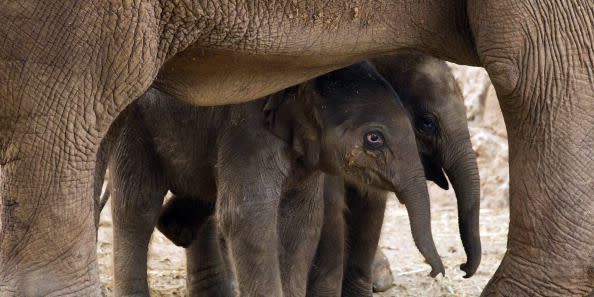It Will Take Millions of Years for Evolution to Replace What We Might Lose in the Next 50

A new study from Denmark's Aarhus University and Sweden's University of Gothenberg shows that animal extinctions are currently happening at such a rapid pace that evolution can't manage to keep up. Without more stringent conservation efforts around the world, it will "likely take millions of years for mammals to naturally recover from the biodiversity losses they are predicted to endure over the next 50," says the study, published in PNAS.
There have been five major extinctions in the history of life on Earth. In 2015, science author Elizabeth Kolbert published The Sixth Extinction, a Pulitzer Prize-winning examination of how humans were moving along the extinction of many species. Using Kolbert's language, the new study shows that many of the Earth's larger land-dwelling species will find life increasingly inhospitable.
"We once lived in a world of giants: giant beavers, giant armadillos, giant deer, etc., we now live in a world that is becoming increasingly impoverished of large wild mammalian species," says Professor Jens-Christian Svenning from Aarhus in a press statement. "The few remaining giants, such as rhinos and elephants, are in danger of being wiped out very rapidly."
One of the marvels of bio-diversity are animals that have distinct evolutionary lineages. An animal like the now-extinct Macrauchenia is a perfect example. With bones originally discovered by Charles Darwin during his voyages famed HMS Beagle, the Macrauchenia can best be described as having the body of a giant llama or camel, the feet of a rhinoceros, and an elephant's trunk. When the Macrauchenia went extinct, it's evolutionary branch went extinct with it. The Macrauchenia had played a unique role in its environment, and evolution needed millions of years to fill that role again.

The closest relatives to the Macrauchenia are the order order Perissodactyla, which includes zebras, rhinos, and tapirs. These are now some the very same animals being threatened by human destruction of the environment.
The black rhino, for example, mainly lives in East Africa and is listed by the International Union for Conservation of Nature (IUCN) as "critically endangered." Other biologically diverse families are also being threatened: The Asian elephant is one of only two surviving species of the mammalian order Proboscidea. Defined by the long trunks and massive size, Proboscidea's ancestry include the mastodon of Ice Age fame. The IUCN list the Asian elephant as "endangered" and notes it has a decreasing population.
"There are hundreds of species of shrew, so they can weather a few extinctions," says paleontologist Matt Davis from Aarhus University, who led the study, in the press statement. "There were only four species of saber-toothed tiger; they all went extinct."
Using computer-based simulations and what the study calls a "birth–death tree framework," the team used expected extinctions to calculate how long it would take the Earth to regenerate its lost biodiversity through natural evolution. They examined extinction from before humanity's arrival and afterwards to look at how difficult mankind had made life for modern animals.
A best case recovery scenario was three to five million years, with over five million years necessary to bring the Earth back to the biological diversity of the Ice Age.
That's why the scientists think that conservation now is a better approach.
“It is much easier to save biodiversity now," says Davis, "than to re-evolve it later.”
Source: Aarhus University
('You Might Also Like',)
